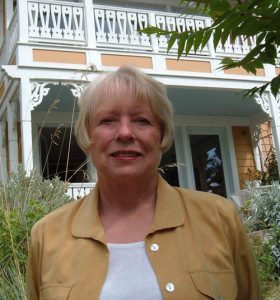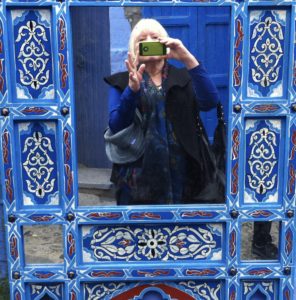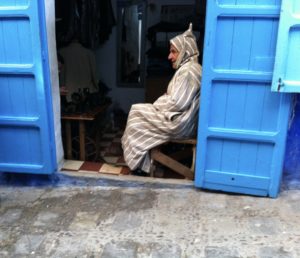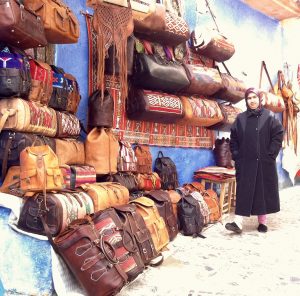This blog will take you to places you’ve always wanted to see and to some you may only have heard of. Its purpose – to immerse you in extraordinary tastes and colors, smells, sights and experiences, infecting you, or perhaps aggravating, an already serious case of wanderlust.
Many thanks for visiting Foreign Writes. Your comments are always welcome. Hope you’ll be back soon!
To view comments or to leave one, please click on the title of the post. Click on photos to enlarge.
Morocco — Marrakesh — The Red City
They call it the Red City — but the plaster that covers many of its buildings is closer to a deep coral. Stunning. It’s become a winter playground for Europeans with the development of modern apartment buildings and hotels like the one we stayed in. We’re surprised when we look out our window and see a lineup of some of the gaudy, but dusty, road  racing Fiat 500s that scooted by us as we crossed the desert.
racing Fiat 500s that scooted by us as we crossed the desert.
It’s quite a walk, or a fair taxi ride, to the old city, to the medina surrounded by 19km of ramparts built a thousand years ago, its wealth accumulated from centuries of trade in slaves, gold, sugar, ivory and leather. Today its 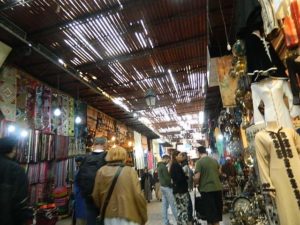 people-packed souk is a labyrinth of shops selling crafts of every quality and just about everything else. We’re totally lost, but wandering is the point.
people-packed souk is a labyrinth of shops selling crafts of every quality and just about everything else. We’re totally lost, but wandering is the point.
Eventually we emerge into the city’s enormous main square — the Djemaa El-Fna. A thousand years ago it was the site of public executions. Its name means Assembly of the Dead. These days it hosts a living theater of oboe playing snake charmers, jugglers, henna tattoo artists, musicians, and the 100 chefs who descend on the square at dusk to set up their tents and grills. It’s a UNESCO World Heritage site.
Parts of the Bahia Palace’s 150 rooms are open to the public. We enter 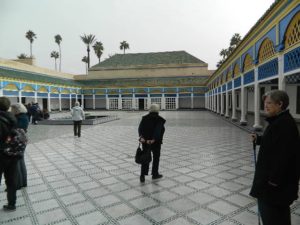 the courtyard of the harem off of which each of Vizier Abu Ahmed’s four wives and 24 concubines had their quarters. Carved atlas cedar on the exterior and intricate plaster and tile and stained glass and silk wall hangings inside. Ceilings a specialty.
the courtyard of the harem off of which each of Vizier Abu Ahmed’s four wives and 24 concubines had their quarters. Carved atlas cedar on the exterior and intricate plaster and tile and stained glass and silk wall hangings inside. Ceilings a specialty.
Hot and thirsty, we see a sign that says Le Jardin Secret — The Secret Garden. We enter and are stunned. Before us is a paradise, an oasis in the middle of the city. It is, in fact, a recently restored 17th century riad, and its new birth, highlighting ancient artisanal skills, is well worth watching. You can see it here. Click on the picture below. An icy lemonade, minty, on the covered roof terrace overlooking the garden. Perfect.
Morocco — Aboard the Ship of the Desert
Legend has it that when a wealthy family refused hospitality to a poor woman, God buried them under the spectacular dune known as Erg Chebbi. Twenty five km long and rising 160 meters above the flat desert floor, its rose colored sands are a tourist magnet. Fortunately, we are there in February, low season, and have the spectacle pretty much to ourselves.
A sunset camel ride to Erg Chebbi and an overnight stay in a Berber tent are on the schedule, but high winds mean we’ll forgo the tent for a comfy hotel which is fine with me. The camel ride is on, though, and our guides lead us to the string of improbable looking beasts crouched in the sand, waiting for us. Climbing aboard is no easy task, but with some 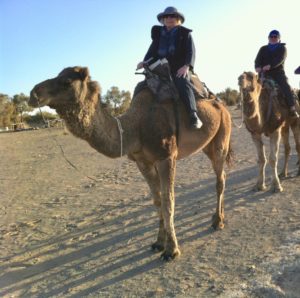 pushing and hauling by a guide, I manage to clamber onto the saddle atop my creature’s hump. For the next bit, I’m directed to hang on to the saddle, front and back. Up go its hind quarters, throwing me forward. Its front legs straighten in time to keep me from pitching over its head.
pushing and hauling by a guide, I manage to clamber onto the saddle atop my creature’s hump. For the next bit, I’m directed to hang on to the saddle, front and back. Up go its hind quarters, throwing me forward. Its front legs straighten in time to keep me from pitching over its head.
Mark is aboard behind me, looking splendid in the blue head scarf he bought from one of our Tuareg guides. It really suits him.
Our group sets off. I’ve ridden horses for a good part of my life, but that experience is no preparation for a camel’s walk which is totally bone-jarring, throwing me forward and back, impossible to follow. A few minutes of this and I’m wondering how travellers traversed thousands of miles aboard these Ships of the Desert.
The view is more than glorious, though, as the sinking sun turns what 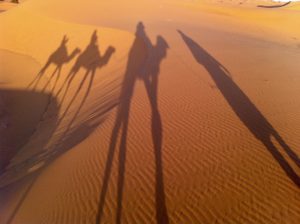 was rose colored all shades of reds and purples and corals, and throws our silhouettes across the sands.
was rose colored all shades of reds and purples and corals, and throws our silhouettes across the sands.
The next challenge is dismounting. Down on its knees my beast goes. I hang on for dear life. Hindquarters lower, and I slide off.
The dunes are steep and the sand shifty, but we make it to the top and take in the panorama and the camels and our guides — a picture I won’t 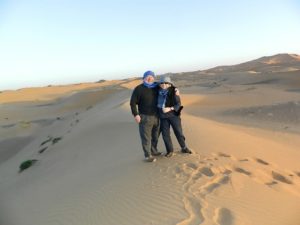 forget. 7FC80159-6041-4042-B0BA-2EB725D52D31_2_0_a
forget. 7FC80159-6041-4042-B0BA-2EB725D52D31_2_0_a
Safely back at our hotel, we’re more than ready for a dinner that begins with a bountiful salad selection 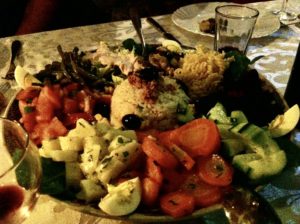 served by a handsome young guy in great headgear.
served by a handsome young guy in great headgear.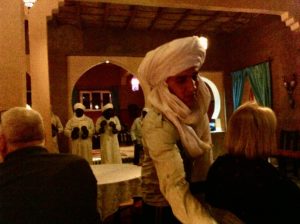
Then it’s music of the desert. A fitting end to our day’s adventures. D9A2FE89-B498-40D7-B58B-6BBE00C0E810
Morocco — Into the Desert
We’re driving across what used to be ocean floor — 500 million years ago. Now it’s a waterless, perfectly flat plain where miners dig shallow trenches in search of ancient fossils. We stop at Macro Fossils Kasbah and marvel at the perfection of squid-like ammonites and trilobites looking something like horseshoe crabs. They’re encased in stone, from ebony black through lightest beige, their delicate forms revealed 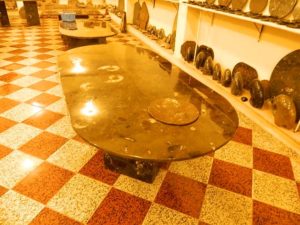 through the painstaking work of craftsman, and polished to mirror finishes. We fantasize about a dining table, or perhaps a bathtub to share with the ancient creatures. We content ourselves with much smaller purchases.
through the painstaking work of craftsman, and polished to mirror finishes. We fantasize about a dining table, or perhaps a bathtub to share with the ancient creatures. We content ourselves with much smaller purchases.
Rissani, and a visit to the souq set up under reed 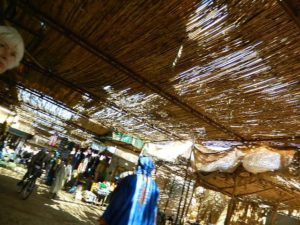 mats, the sun striping the fruits and veg and spices, most of which arrived here this morning via the
mats, the sun striping the fruits and veg and spices, most of which arrived here this morning via the 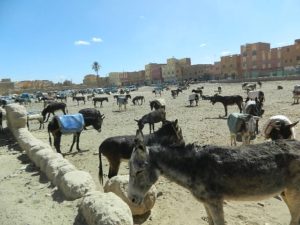 donkeys waiting in Rissani’s parking lot.
donkeys waiting in Rissani’s parking lot.
We’re served artisanally prepared tea in the rug shop where some of us 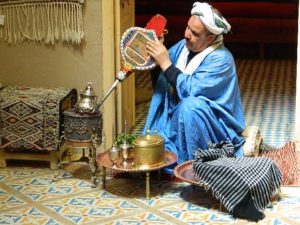 succumb to temptation.
succumb to temptation.
Post-lunch, our four wheel drive vehicles are waiting. There are no roads to Merzouga and the dunes, no landmarks, nothing but packed sand and some vague tracks — but we have faith that our drivers have done this before. In the midst of this nothingness, we’re suddenly surrounded by brightly painted Fiat 500s, garish beetles speeding past us across the desert in a road race that ends in Marrakesh. Surreal.
Merzouga — 35 miles from the 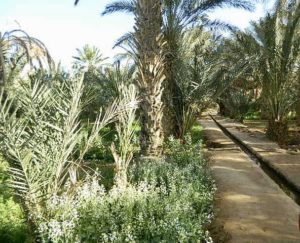 Algerian border. Green in the middle of the desert, irrigated by small channels that criss-cross the sand, that tap the largest underground reservoir of water in Morocco.
Algerian border. Green in the middle of the desert, irrigated by small channels that criss-cross the sand, that tap the largest underground reservoir of water in Morocco.
We visit a girls school — basic literacy and sewing.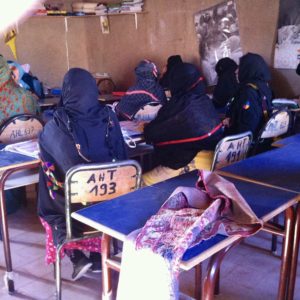
Next up? A sunset camel ride in the dunes. Is this a good idea?
Morocco — Up and Over Morocco’s Spine
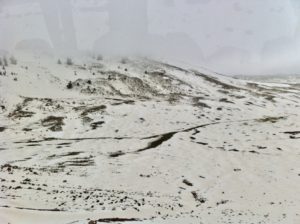 We’re headed for the desert — the ‘real’ Morocco. But first it’s over the Atlas Mountains. We climb through foggy forests of Atlas cedars through snow fields — not something I expected to see in Morocco.
We’re headed for the desert — the ‘real’ Morocco. But first it’s over the Atlas Mountains. We climb through foggy forests of Atlas cedars through snow fields — not something I expected to see in Morocco.
Ifrane is another surprise. We make a cafe stop in what appears to be an upscale Alpine resort. It was built by the French in the 1930s (most of Morocco had been theirs since 1912).  Today it’s where wealthy Moroccans come to ski in the winter and escape summer’s heat.
Today it’s where wealthy Moroccans come to ski in the winter and escape summer’s heat.
Morocco is skinny and long, starting on the shores of the Mediterranean, arcing South and East along the rim of the Atlantic, ending in a disputed border deep into the continent. The mountains are its spine, snaking down its middle, dividing the country, not only geographically. As we descend, we leave behind the well watered coast, the French influenced cities, the Western dressed citizens. Every hairpin turn takes us closer to the austerity of the desert, to people dressed to protect from its heat, to different ethnic majorities, to societies that still retain ancient tradition. To Berber country
They’re more properly called the Amazigh, meaning free people. It was the Romans who named them Berbers — barbarians. The name stuck. So did anti-Amazigh prejudice. These indigenous Moroccans, who make up 60% of today’s population, trace their history back 7000 years, long before the Arab invasion in the 7th century that brought with it a dominant alien culture. Times are changing, though, as the Amazigh assert political power and gain access to equal resources.
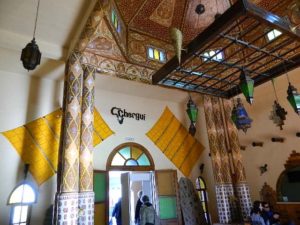 After a stop at our first date palm oasis — and purchase of the sticky sweets, of course — we head for Erfoud and the Kasbah Hotel Chergui. Dinner features madfouna, a calzone style dough pocket stuffed with minced onions and herb-spiked lamb, baked until golden and puffy.
After a stop at our first date palm oasis — and purchase of the sticky sweets, of course — we head for Erfoud and the Kasbah Hotel Chergui. Dinner features madfouna, a calzone style dough pocket stuffed with minced onions and herb-spiked lamb, baked until golden and puffy.
 And after dinner, a performance of Malhoun music — AD534B72-7774-4945-8671-E2E32DC95BE1 — known as sung poetry. Click above to have a listen.
And after dinner, a performance of Malhoun music — AD534B72-7774-4945-8671-E2E32DC95BE1 — known as sung poetry. Click above to have a listen.
An early night tonight. Tomorrow it’s into the desert.
Morocco — Chefchaouen — The Blue Pearl
The city, sitting at the base of the Ras Mountains, was founded as a fortress against the Portuguese in 1471. Shortly after, it received an influx of Jews and Moors expelled from Spain as a result of the Decree of Andalus at the climax of the Reconquista. Some attribute the blues of the city to the Jews who associated the color with heaven. Some say it was a protection against mosquitos.
It’s a laid back place, maybe due to its other claim to fame as Morocco’s kef (marijuana) capital.
We arrive at our hotel, Dar Eschchaouen, in the evening, too late to explore the city that twinkles below, but the next morning we get what we’ve come for — immersion in blue.
Nothing quite prepares you for your entry into Chefchaouen’s medina.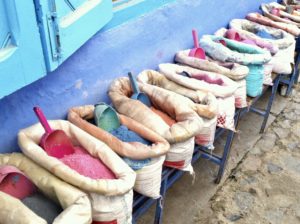
Our guide is full of stories as we walk the narrow streets – including 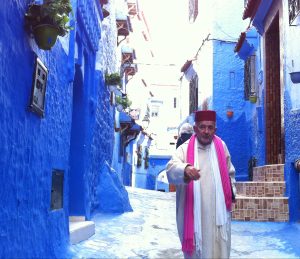 about his favorite client — Barrak Obama– with whom he says he keeps up an email correspondence.
about his favorite client — Barrak Obama– with whom he says he keeps up an email correspondence.
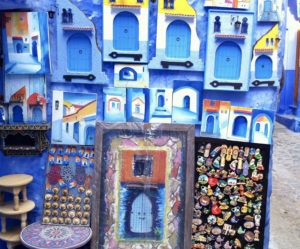 Its blues make a perfect backdrop for the crafts displayed against them.
Its blues make a perfect backdrop for the crafts displayed against them.
Known for its leather and woolen cloth, every turn is a temptation, a photo-op, and a new feast for the eyes.
